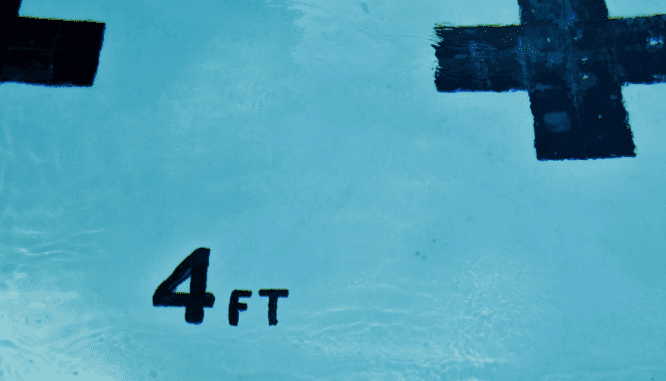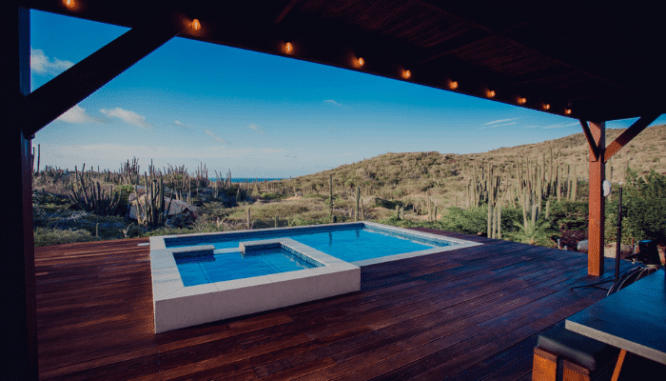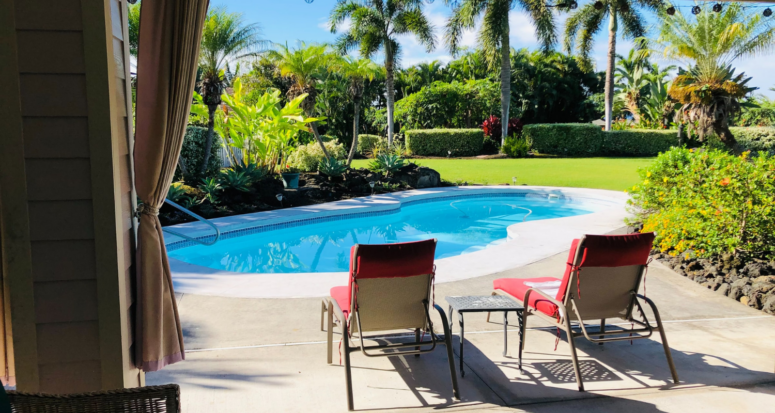Create the Backyard of Your Dreams With These Dazzling Pool Design Ideas
- Published on
- 9 min read
-
 Mikayla Uber Contributing AuthorClose
Mikayla Uber Contributing AuthorClose Mikayla Uber Contributing Author
Mikayla Uber Contributing AuthorMikayla is a writer and content specialist from Portland, Oregon with experience writing about travel, women’s health and beauty, and the luxury hotel industry.
Few things say summer like days spent beating the heat poolside, especially when the pool happens to be in your own backyard. If you’re adding or remodeling a pool, you’ll need to sort through hundreds of pool design ideas to determine the best size, shape, materials, and features for your personal paradise.
The good news is, if you design a stunning pool, you’re likely to recoup a hefty chunk of your investment at resale. Recently, the demand for swimming pools has soared as beaches and public pools across the country closed in response to the coronavirus pandemic.
According to Eileen Long, an associate with top real estate agent Janine Kowalski in Port St. Lucie, Florida, today’s buyers are willing to pay significantly more for pool homes than they were pre-pandemic.
“If you have two houses that are right next door to each other and one has a pool and one doesn’t, the house with a pool can ask for $50,000 more and absolutely get it,” Long shares, noting that pools only added $20,000 in value the years leading up to the pandemic.
In HomeLight’s Top Agent Insights Report for Spring 2021, agents from across the country echo Long’s observation. Nationally, the amount of value an in-ground pool adds to a home has increased an estimated 69% on average since the arrival of COVID-19.
We spoke with Kowalski and Terry Argenziano, COO of The Pool Boss, New Jersey’s top in-ground swimming pool company, for insight into trending pool design ideas. Dive into our round-up of the eight essential pool design features.

1. Design a pool that’s max one-third of your yard size
There’s a swimming pool design for every outdoor living space, including those long and narrow yards and petite plots of land. According to Long, the ideal pool should occupy one-quarter to one-third of the total outdoor area.
For smaller yards, Argenziano says the new trend is the “spool,” or spa-pool combination. “It’s a miniature pool that you can use as a spa,” Argenziano says.
Measuring approximately 10 feet to 16 feet long and 6 feet to 8 feet wide, spools are noticeably smaller in size than the typical in-ground swimming pool. Their small size allows spools to heat up quicker and for less money than larger swimming pools. Spools are also easier to maintain and keep clean for this same reason.
2. Choose the most durable pool material for your budget
Here’s an overview of the three main types of in-ground pool materials:
Concrete
Concrete is the most popular (and expensive) type of pool. The average cost for in-ground concrete pools is around $60,000. Construction time varies between 3 to 12 weeks on average, longer than the time it takes to build pools from other materials. Still, many homeowners opt for this material since it is highly durable.
Vinyl-liner
The popularity of vinyl-liners is growing — this material is now the second-most popular choice for in-ground pools. Vinyl-liner pools are built with a one-piece liner set into the excavated ground and attached to a steel or aluminum-framed wall. Vinyl-liner pools typically take three to six weeks to build.
While vinyl-liner pools are cost-effective (the average installation cost is around $45,000), they’re not as durable as concrete pools. Vinyl deteriorates over time with exposure to elements. Some liners are equipped with UV inhibitors which can extend the life from 10 to 18 years.
Fiberglass
A fiberglass swimming pool consists of a large, single-piece shell placed in an excavated hole in your backyard. Unlike concrete and vinyl pools, fiberglass pools are pre-made, meaning there is little room for customization. However, fiberglass pools are the quickest to build, taking just 14 to 30 days to install on average. The initial cost of a fiberglass pool is higher than vinyl, costing $50,000 on average.
3. Decide which pool shape flatters your yard and home
Pool shape can complement or clash with your backyard’s design. Here are some common shapes to inspire your design process:
Rectangle
The classic rectangle is the most popular shape for backyard pools right now, according to Argenziano. This simple shape is relatively easy to build and complements most architectural styles, especially farmhouse, contemporary, and Craftsman homes.
Kidney
Originally designed by architect Lawrence Halpin in 1948, the kidney-shaped pool became a popular alternative to rectilinear pool styles. You can easily integrate the curving, organic silhouette into your surrounding landscaping for a more natural-looking water feature. Kidney shapes also complement the low-profile architecture, especially one-story, ranch houses, and modest cottage homes.
Oval or round designs
A new kind of pool was born in the 1930s with the rise of curvilinear shapes. Oval and round pools got their start in the backyards of Hollywood’s elite when pool builder Philip Ilsley created the first round-bottomed pool frame. Today, oval and round designs remain popular shapes for residential swimming pools. The soft curves complement most architectural styles, especially traditional homes.
L-shaped
If your backyard has an irregular shape, an L-shaped pool can help you fully utilize the space. L-shaped swimming pools consist of two small rectangles joined together at a right angle. There are two types of L-shapes to choose from: a true L, which resembles the letter, and a lazy L, which suggests the letter but has a slight angle. Some homeowners take advantage of the two-part shape to sharply define the shallow and deep end.

4. Determine your ideal pool depth
When you’re installing a new pool, depth is another important factor to consider. The standard backyard pool has a shallow end on one side that transitions to a deep end, but you can also opt for a pool that’s shallow on both ends and deeper in the middle. Remember, different uses require different depths. Here are the recommended depths based on the purpose of the pool:
Water sports
If you want to use your pool to play water-based sports like volleyball, pool designers recommend a depth of 4 feet. This depth makes it possible for adults to stand and play easily in the water. This depth is also ideal for casual wading and socializing.
Play zone for kids
A traditional pool will have a shallow end on one side, usually about 3.5 feet deep. Shallow ends are a great feature if children or inexperienced swimmers are using your pool. According to Argenziano, more homeowners are opting for shallow pools today.
“With more people spending time at home and using the pool more than ever before, a more shallow deep end is popular because it creates more usable space in the pool for recreation and lounging.”
Lounge
A wading pool is a small area of shallow water where small children and adults can get their feet wet. They are usually around 2 feet deep and are ideal if you only want to get the lower half of your body wet. Kids can also chill out, play, and splash around safely at this depth.
Lane swimming
The depth of a lane or lap pool depends largely on user preference. Typically, the average depth is around 4 feet since this gives you enough water to swim laps comfortably. However, if you will be diving into your pool, a depth of 6 feet is safer.
Diving
If you add a diving board to your pool, you’ll need a minimum depth of 8 feet. The height and type of diving board determine the pool depth required to keep you safe from harsh impacts. The higher the jump, the deeper the pool should be.
5. Summon summer with these pool styles
Will you design a tropical escape or a sleek modern infinity pool? There’s an endless array of swimming pools styles to choose from. Here are a few of today’s most popular styles:
Hamptons-inspired
Trending pool design styles vary by area. In New York and New Jersey, people can’t get enough of the Hamptons-style pool. This pool style features a classic rectangular shape, traditional edging, cool coastal decor, and lots of luscious green grass around the pool area.
Tropical
Bring the beach to your home with a tropical pool theme. Tropical pool design is most popular in areas where pools are used year-round, such as California or Florida. Tropical pools are often include dramatic lighting, stones, fire pits, tiki bars, and soft, beachy materials. A pebble finish can also help create a natural-looking design. This material costs between $8,000 to $15,000 depending on the type of pebble used and lasts anywhere from 10 to 20 years.
Modern
Modern pools are typically geometric in shape and minimal in design. This style favors clean lines and neutral colors. Up the ambiance around your pool by adding a fire pit, rectangular couches, and structural plants like yucca, succulents, and cacti.
Natural stone
For a pool that blends seamlessly with the surrounding landscape, consider using flat stones for steps, benches, and waterfalls. There are a variety of different natural stone decking options available, including travertine, flagstone, and slate. Bluestone is a fantastic choice for an outdoor space surrounded by natural charm — it’s a durable, non-slip, and water-resistant material. Keep in mind that you’ll need to periodically seal natural stone to protect it from weather and pool chemicals.
Mediterranean
Reminiscent of an Italian villa, Mediterranean pools evoke an Old World charm. They feature colorful tiles, often hand-painted in royal blues, oranges, and natural tones, and terracotta or stone pavers. The surrounding landscape mimics Italian and Greek landscapes with olive, cypress, and citrus trees.

6. Float the day away with these fantastic pool features
Once you have the basics down, it’s time to explore the most fun pool design ideas — features. Elevate your pool space with these decorative and playful features:
Baja shelves
Baja shelves, also called tanning shelves or sun decks, are a popular trend on the rise. According to Long, this is the most desirable feature for homebuyers in Florida at the moment. Typically, the shelf is a flat area 8 inches to 16 inches under the water. It’s the perfect spot to lay on a chaise lounge and soak in the sun, coconut cocktail in hand. Young children can also sit and play in this area since it’s not as deep as the rest of the pool. If you want to include this feature, expect to pay around $2,500.
Beach entrance
Adding a beach entrance, also known as a zero-entry, is another great way to create a backyard swimming oasis. This sloped, gradual entrance mimics the feel of a natural beach or lake. While there’s no denying this feature is great, be warned that it can cost you up to an additional $7,000.
Swim-up bars
With more and more people wanting the tropical resort experience in their backyard, swim-up bars are becoming more popular. The bar design may simply include a surface higher than the water line to rest drinks on or include bonus features like underwater stools and an overhead shade. While the price depends on your specific design, the average swim-up bar costs around $5,000.
Waterfalls and deck jets
If you want to add some jewelry to your pool, consider adding water features like waterfalls or deck jets, streams of water that shoot out into the pool. Argenziano shares that a recent client requested a pool with a sheer descent waterfall featuring fire bowls at the top.
“It is a show stopper. Fire and water are two elements that, when side-by-side, create a really powerful statement,” she adds.
While costs for water features vary widely, typical pool waterfalls add about $7,000 to $10,000 to your total price.
7. Dream up a beautiful outdoor living area
Shape, depth, and size aren’t the only things you have to consider when designing your pool. Sometimes the space around your pool also needs a little TLC to make it comfortable for you and your guests.
Argenziano recommends thinking about everything you want in your dream backyard before you start building your pool. “You want to make sure that the entire space is what you want, even if it takes longer or you don’t have the pool for one extra summer,” she says.
Here are some tips for creating a beautiful outdoor living space:
- Style a lounge area with outdoor furniture: Outdoor furniture is a must for lounging and having guests over. If you plan to host pool parties regularly, go for a large outdoor table flanked by benches. Or, if you spend a lot of time soaking up the sun, pick a chaise lounge and comfy chairs to stretch out on. Arrange your furniture to make the most of your space. For example, set up a small sitting area to watch the sunrise with a coffee or a table and chairs for guests to view the sunset.
- Add accessories to boost comfort: Between decorative throw blankets, umbrellas, outdoor rugs, and pillows, there are tons of ways to make your outdoor living area cozy from day to night. Create a shaded area in your outdoor living space with umbrellas or canopies to stay comfortable on hot days. And add an outdoor fireplace to keep warm at night.
- Build a deck or patio space: Choose the best decking material for your needs, considering your budget, material maintenance, and intended use. Today, pressure-treated wood is the most popular type, with around 75% of new decks using this material. It has a relatively low price point ($1.50 to $2.50 per square foot) and is chemically treated to withstand mold, pests, and rot. Other common materials include concrete, redwood, tropical hardwood, cedar, and composites.

Pool design ideas are endless
Once you have the basics for your pool down, reach out to pool contractors to compare portfolios and prices. Professionals will give you even more pool design ideas to play with. When you get your pool design right, you’ll feel like you’re on vacation in your own backyard. No passport or hotel reservation required.
Header Image Source: (Meg Hill / Unsplash)
